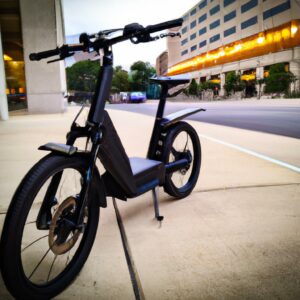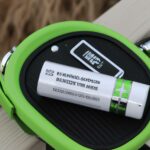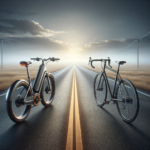Introduction to the world of electric bikes
Welcome to the exciting world of electric bikes. These innovative modes of transport have captured the imagination of commuters, hobbyists and outdoor enthusiasts alike.
With an electric bike, you get all the benefits of traditional cycling while enjoying the added advantage of a power source. Most electric bikes come with an onboard battery, motor and controller. All you need to do is pedal and the in-built motor kicks in, amplifying your pedalling power, thus helping you cycle further faster and with less effort than on a traditional bicycle.
One of the most significant advantages of owning an electric bike is the convenience and flexibility it provides. With an electric bike, you can travel long distances with ease, or commute to work without having to break the bank on fuel or worrying about parking. Additionally, people from all walks of life can use electric bikes for fun activities like leisure cruising or exploring trails.
- If you’re yet to take the plunge, we recommend that you avail of the opportuity to try out an bike. You might be pleasantly surprised at how quickly you’ll come to appreciate the benefits they offer.
Understanding the concept of watts and how they affect bike power
Electric bikes operate using a battery-powered motor that provides their movement, commonly referred to as an e-bike. The power of a motor is simply the amount of work it can perform in a specific amount of time, and this is measured in watts. So, when referring to the power of an electric bike, we are talking about its wattage.
The amount of wattage on your e-bike directly determines how much energy it is capable of delivering at any given time. Put simply, a higher wattage means more power and energy delivered to the motor. Therefore, more wattage means an electric bike is capable of reaching higher top speeds than one with less wattage.
- Low Wattage Electric Bikes:
- The most commonly used electric bikes are those with a wattage range between 250-350 watts. These often have a maximum speed of around 20mph and are great for use in cities or for casual rides on flat terrain.
- Mid-Wattage Electric Bikes:
- E-bikes with wattages ranging between 350-500 watts are perfect for off-road terrains and hilly areas. These bikes provide extra power that makes it easier to ascend steeper hills, while the maximum speed will typically hover around 28mph.
- High Wattage Electric Bikes:
- A bike with a wattage above 500 watts will give riders plenty of power at top speeds exceeding 30mph. These high-powered bikes are typically used for off-roading or competition purposes with riders looking to push themselves to the limit.
It’s worth noting that there’s typically a tradeoff between the amount of wattage and the range. High wattages require more battery power which can impact how far you can ride on a single charge.
Overall, the wattage on your electric bike determines just how fast it’s capable of going. The more powerful your e-bike motor is, the faster it will travel. Consider your needs, daily activities, and intended use when selecting an electric bike that best meets these needs when it comes to watts and bike power.
Different types of ebikes available in the market categorized by wattage
Electric bikes, also known as ebikes, have taken the cycling world by storm. They are becoming increasingly popular among commuters, sports enthusiasts, and casual riders alike. There are various types of ebikes based on their design, size, and of course, their wattage.
- Low Wattage Ebikes: These are the smallest and lightest types of electric bikes that run on 20-200 watts of power. They use a small motor and battery to provide pedal assistance and help the rider climb uphill and tackle rough terrain.
- Mid Drive Ebikes: These models utilize more powerful motors with an output ranging from 250W up to 500W. Mid-drive e-bikes generate a higher torque resulting in better hill-climbing performance; they are also suitable for e-road and e-gravel riders seeking more endurance or training versatility.
- High-Wattage Ebikes: High-wattage ebikes employ some of the most potent 250W+ geared, smart torque sensors. These are designed to handle different riding condition^s with their extensive rear-wheel suspension for off-roading and intricate riding techniques. They’re ideal for delivery services, civic workers, police, and animal control officers who are required to make rigorous treks consistently.
- Super Charging Ebikes: A relatively new addition to the market, super charging electric bikes offer immense speeds, greater than other variants that operate on; these high-performance models use large combo hub smartphones box *motors putting out more immense wattage. The instant acceleration burst able to get you up hills and anywhere quite quickly.
An electric bike’s wattage defines its ability to work as a durable and reliable source of transport. Understanding the different models categorized by wattage facilitates your choice whenever shopping for an ebike interesting while differentiating types powered by varying user needs and preferences.
The advantages of using an electric bike over traditional bikes
Electric bikes, also known as “ebikes,” are revolutionizing the way people commute and travel. They offer numerous benefits over traditional bikes and can positively impact our everyday lives.
- Easier pedaling: With the help of a motor, ebikes assist you while pedaling, making commutes or longer rides a breeze. Traditional bikes require more energy and endurance to maintain a consistent pace, causing exhaustion for some individuals.
- Faster travel: Compared to traditional bikes, electric bikes can travel at increased speeds with less effort. This makes them an attractive option for those who need to cover distances quickly or arrive at their destination without showing up sweaty or out-of-breath.
- Environmentally friendly: Ebikes emit fewer gases than cars or traditional motorcycles, making them not only better for your health but the environment, too. They have the benefit of reducing traffic congestion and noise pollution.
- Save money: Besides being fun, electric bikes incredibly are also cost-effective. They allow the rider to save money on gas and car expenses while remaining a convenient, alternative mode of transportation. Ebikes are cheaper than full-sized vehicles, both in purchase and maintenance costs too.
- Exude convenience: Unlike traditional bicycles that may become a chore to ride due to inconveniences like storage and needing to physically exert yourself, ebikes eliminate those troubles with simple fitness. They come with add-on features that cater to day-to-day transportation challenges, and these include storage racks, baskets, and well-padded saddles for comfy rides.
In conclusion, ebikes are an exciting evolution of traditional bikes offering numerous benefits in practical usage, environmental sustainability, and cost-effectiveness. As such, electric bikes provide an alternative form of transportation that blends extreme fun and a more stress-free riding experience. This makes them top contingency choices for healthy and convenient commuting.
Factors that Affect the Speed of an Electric Bike
Electric bikes are an inventive solution to the problems faced by traditional bikes. They offer many advantages, the most apparent of which is speed and convenience. Understanding the different factors that affect the speed of an electric bike can assist you in getting a more personalized experience as you ride.
The first factor that affects an electric bike’s speed is the type of terrain you will be riding on. Uneven and uphill paths will require more motor power, leading to slower speeds when compared to riding on flat terrains. Also, harsh weather conditions like heavy rain or strong winds can affect the e-bike’s top speed.
The second factor that impacts electric bike speed is your own body weight. If you weigh more, you will require higher motor power to attain the same speed as someone who is lighter. Therefore, heavier people may encounter slower bike speeds on hills or may have lower maximum speed when compared to those who weigh less.
The third factor that influences speed of electric bikes is the battery capacity of the e-bike. Larger battery capacity means that the bike will go faster and for a longer duration. Oftentimes, when a battery gets weak, the e-bike’s top speed is reduced since the electric motor’s power output diminishes.
The fourth and final factor affecting ebike speed is the wattage of the motor itself. The majority of electric bikes in the market categorise their rating into wattage, ranging from 250w to 1000+w. In order to reach higher speeds, you’ll want a more effective engine with a larger wattage which users should ensure that they check or ask for this feature while buying an e-bike.
- Terrain or surface type
- Bodyweight of the rider
- Battery capacity of the bike
- The motor’s power output or wattage.
By considering these factors, you will be in a better place to reach top speeds on your e-bike and remain safe and comfortable.
The Role of Motor Power and Wattage on Electric Bike Speed
If you’re looking to buy an electronic bike or you’re simply curious about how electric bikes work, you’ve probably wondered how motor power and wattage impact speed. The motor is responsible for propelling the bike forward, and a powerful motor means a faster bike.
This may all seem quite straightforward, but there are many factors in play when it comes to e-bike speed. These include things such as battery size, the weight of the bike, the terrain being ridden on, and the amount of pedaling power being used by the rider.
When talking about motor power and wattage, most bikes tend to have motors that range anywhere from 250 watts up to 750 watts or even higher. While more power means a faster bike, there are tradeoffs to consider. A higher wattage means a bigger and potentially heavier motor, which can lead to decreased efficiency and range due to increased energy consumption.
- 250-350 watt motors: These motors usually run decently on flat roads with little resistance. You can generally expect a top speed of around 20mph.
- 500 watt motors: This range is the “sweet spot” for most e-bike users and typically reaches a maximum range 28mph or higher.
- 750-watt motors and above: With large-sized motors, you can accelerate faster and reach an impressive top speed while sacrificing efficiency. Be aware, the higher wattages may not adhere to road regulations and can be illegal in some regions based on their designated classification.
It is essential to note that motor function can be accompanied by a throttle mechanism. A throttle is essentially a ‘fast grip’ attached to the handlebars. It either pushes the bikes pedals or provides power directly to the engine. A throttle allows you to accelerate forward – with very little pedaling required.
To sum everything up, higher wattage doesn’t automatically mean faster and better speed is achieved with wider wheels. Optimal bike speeds can be established based on personal preference, legal restrictions, weight, terrain, and more.
Comparison of the Speeds Achieved by Ebikes with Different Wattages
Electric bikes come in different wattage levels ranging from 250w to as high as 750w. The question always arises – how fast can an electric bike travel? The speed of an electric bike is mainly a function of motor power, battery capacity, terrain, weight of the rider and bike and bicycling conditions.
- A 250w electric bike can reach speeds of up to 20 mph on average terrain.
- A 500w electric bike can attain speeds of up to 30mph on a flat road.
- A 750w ebike is known to achieve speeds up to 45mph in ideal conditions.
The power on the motor of an ebike dictates its maximum speed as well. An electric bike’s maximum speed is programmed, set and controlled against watts. If the limit is set higher than what is provided by the motor installed on the e-bike, it will become ineffective to improve to speed. Terrain diversity also plays a crucial role in regenerating and accommodating speed. Hills are always a challenge but require more power to ascend leading back down effortlessly at gravity speed possible.
When comparing different wattages for ebikes, riders need to consider vehicle laws in their respective regions and vibrations caused by the higher speed nature of scooters and e-bikes. Also important to note is your driving manner with respect to location. The motor controller limits ebike speed to balance power and safety, however downslope gradients contribute to increasing and amplifying electric bike speed and autonomous energy.
Choosing the right wattage class of e-bikes will depend on individual use interests, surrounding features, and policies that encourage active mobility requests including shared streets/paved pathways that make for calm-movements.
How a 500w Electric Bike Compares to Other Ebike Wattages in Terms of Speed
If you’re looking for an electric bike, you might have noticed that there are different types available based on their wattage. One of the common questions people ask is how fast a 500w electric bike can go compared to other ebike wattages.
- The average speed of an electric bike varies based on factors such as terrain, weight capacity, aerodynamics, among others.
- A higher wattage doesn’t necessarily mean a faster bike.
- The weight of the bike and its components also play a significant role in determining how fast it can go.
However, if we were to conduct a single test and compare how fast different ebikes can go, the results would show that a 500w electric bike can achieve an average speed of 20 to 28 miles per hour depending on various factors.
A 250w ebike on the other hand, typically has an average speed between 15-20 mph, while those with 1000w can reach up to 35 mph under optimal conditions. However, it’s important to note that top speeds aren’t the primary concern for most bikers, particularly when using an ebike for commuting or urban riding.
To achieve a swift ride with a 500w e-bike, we recommend that you pay attention to the ideal weight allowances,cycling condition optimization;use lower gears when going uphill and high gears when going down just to mention a few.
You need to rightly set the Power assist level as this will influence your speed.All Level I will give a minimal boost Level II too much power and hard on fitness-building Low user control Level III Better climbing capacity and reasonable speed contribution and lastly Level I which provides the closest riding experience to a regular bicycle.Customizing this function is just dependent on your personal taste.
In conclusion,the mph gain by’upgrading’ factors can only improve slow ebikes.However, it’s up to the individual preference to the ideal speed and how much watts they may need to get to their destination.
Legal restrictions around ebike speed in various regions and countries
Electric bikes come with the advantage of being fast, but it’s important to know the legal speed limits if you want to avoid running afoul of the law. Electric bike speed limits vary from region to region and country to country. Before setting out to ride your 500w ebike, it’s imperative to familiarize yourself with the regulations applicable in your area.
In the United States, the federal law regulates ebikes with a maximum power output of 750 watts. However, the laws also vary depending on the jurisdictions you plan to travel within the US. Most states allow ebikes to go as fast as twenty to thirty miles per hour in class three, although some limits may vary by locale. In California, for instance, where they’re prevalent, EBikes are treated like traditional bikes, which can run up to twenty-eight miles per hour. Nonetheless, ebikes traveling on sidewalks or car-free pathways in urban centers still need to obey a lower speed limit posted for that specific zone.
In Europe, electric bikes must adhere to the regulations stipulated in the EU manufacture law, which categorizes EBikes according to their ability to provide pedal assistance along with power output. For a 500w ebike featuring speed pedelec, the max limit the bike can achieve should not exceed twenty-five miles per hour or forty kilometers per hour, according to EU e-bike laws.
Some countries have relatively strict rules and regulations when it comes to e-bike speed. In Australia, ebikes get set into several categories with specifications linking to maximum engine size (wattage) measurements or top speeds, which decides whether helmets are required for the cyclist.
When preparing to purchase an e-bike, research the regional electric bike guidelines and speed regulations that stipulate electric bike speeds to protect yourself and your enjoy the experience accordingly.
- Know your local/legal maximum ebike speed as set nationally or locally
- A helmet must be worn when exceeding speed limits in certain countries.
Tips for maximizing the average speed of a 500w electric bike
As we know, an electric bike with a 500w motor can deliver impressive speeds on the road. There’s no substitute for experience and each rider is unique but for the purpose of our guidance here are some valuable tips to increase your 500w electric bike speed.
- Keep your bike well-maintained: As with any vehicle, regular maintenance will ensure that your electric bike is operating efficiently. Checking your tires’ air pressure before each ride will prevent unnecessary resistance and friction on the road.
- Pedaling in conjunction with battery production: The powerful motor in a 500w e-bike produces a large amount of power to store and convert into movement. When you pedal alongside the motor power, potential range is significantly boosted and eases the power that gets stuck in consumption.
- Monitor battery cycle and temperature: High temperature leads to capacity decline, whereas low temperatures could lead to shorter range as warmer lithium-ion battery cells are likely to perform better and avoid inconsistent current flow. Regular cycling technique and effective monitoring devices both reduce memory effects and extend overall performance lifespan.
- Tilt it forwards: Tilting your body weight elevates aerodynamics making your 500w e-bike drive smoother into wind gusts and air force. Critical aligning permits streamlined transportation where reduced resistance converts into additional speed.
- Isolate and supercharge your bike components: Reducing bike weight helps to limit air resistance and wastage speed during climbing hillsides. Utilize top-of-the-line components that decrease fativeness while increasing user flair and attraction is the aim behind supercharging style.
Electrified bikes can attain furious speeds with relative tandem driveliness, but speed shouldn’t be fateful over your safety nor powerfulle appeal on your bike journey. Remember to always wear a helmet and other appropriate protective gear when riding an e-bike on public roads. Abiding by legal protocol is Imperative in yours as well as the safety of others. Use at your comfort.
Safety considerations when riding an electrified vehicle with high speeds
Electric bikes of high wattage can achieve exhilarating top speeds, but with great power, comes great responsibility. You need to take into consideration various safety factors before purchasing and riding an ebike capable of high speeds.
- Wear protective gear: As with any bike, it’s essential to wear a helmet when riding an electric bike irrespective of its power output. For high-speed ebikes, gloves and knee pads are highly recommended as you need to be prepared for potential falls and impacts more than traditional bikes.
- Familiarize yourself with the bike’s control: Before venturing out onto the road or other public places trails, take some time to familiarise your self with the ebike’s controls such as the brakes, motor, throttle and LCD screen if available. Ensure brake cables and other components of the bike are working properly before you start riding.
- Abide by local traffic laws: Even though there might be legal grey areas regarding ebike speed limits in some regions, it’s always wise to follow the standard traffic rules regarding maximum speed, right-of-way and use of bike lanes to minimize accidents and run-ins with law enforcement officers.
- Consider purchase of liability insurance: although not mandatory in most regions, buying liability insurance offers some financial protection from injuries you could sustain while riding an ebike.While choosing an insurance policy, ensure it covers the relevant state or regional administered ebike laws and regulations po from damages inflicted on third parties with liability coverage.Suff
- Maintain your bike regularly: Regular maintenance of your ebike’s mechanical and electrical components helps prevent accidents due to bike or faulty parts failure. Keep in mind that the high speeds of ebikes tend to lead to more intensive wear and tear than regular bikes, so they require good care and specialized attention.
- Ride defensively: Unlike traditional bikes, ebikes tend to have greater acceleration while may mainly sensetizesome riders to take unnecessary risks. Every time you ride ebike with impressive acceleration skills, Ensure you’re always aware of your surroundings and other vehicles so that your safety is as high as possible.
Your safety should be your number one priority when riding an electric bike, it gives you fantastic riding experience, but that never fix havocian incidentliable speeds are racing-like pace on major roads. Ride your ebike responsibly ultimez
Conclusion – making an informed decision on owning a 500w ebike
Now that you’ve learned about the world of electric bikes and how watts affect their power, you may be interested in purchasing a 500w ebike as they offer optimal power without any legal complications in most regions. However, before rushing to buy one, consider these key factors:
- Safety should always be your top priority when riding an electrified vehicle with high speeds. Always wear appropriate protective gear and adhere to safety guidelines when using your 500w ebike.
- Understand the legal restrictions regarding ebike speed in your region or country. Some locations impose regulations on maximum speed limits or require licensing and registration for bikes over specific wattage limits.
- Maximizing the average speed of your 500w ebike can be achieved by considering factors such as terrain, weight of the rider, and tire pressure.
- The type of ebike that best suits your lifestyle depends largely on your transportation needs and personal preferences.
Keep these factors in mind when making your final decision. A 500w ebike can be a great investment if you prioritize speed and functionality but it’s important to ensure that it is used safely and legally. With all this information at hand, you are now equipped to make an informed decision that best suits your individual needs and requirements.
FAQs – information about how fast a 500w ebike can go
- Q: What is an electric bike?
A: An electric bike is a bicycle that is equipped with an electric motor that helps to propel the bike forward. - Q: How do watts affect an electric bike’s power?
A: Wattage indicates the power of the motor that drives the bike. Higher wattage results in an electric bike that has more speed and power. - Q: What are the types of ebikes categorized by wattage?
A: Ebikes come in various wattages ranging from 250 watts to 1000 watts or above. These different wattages comprise e-bikes such as commuter, road, mountain, fat tire, and folding electric bikes. - Q: What are the advantages of using an ebike over traditional bikes?
A: There are numerous benefits to using an electric bicycle, including ease of use, environmental friendliness, health benefits, better travel time, affordability, and versatility. - Q: How much does the speed of an ebike affected by factors other than wattage?
A: The speed of an electric bike frames depends on several factors such as the battery condition, tire pressure, rider weight, terrain, temperature, gear mechanism, level of assist set, etc. - Q: How does motor power and wattage impact an electric bike’s speed?
A: A higher unique bike motor wattage rating will contribute to higher electric bicycle speeds; however, other factors can also impact this. - Q: How fast can a 500w ebike go?
A: Usually, a 500w ebike can achieve a top speed of about 20-28 mph (32-45kph).
comments: 0




